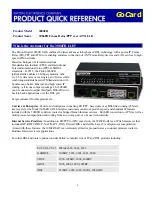
TEMPHION INSTRUCTIONS
Seametrics • 253.872.0284
Page 10 seametrics.com
INSTALLATION
Installing the Sensor
The black reference reservoir at the lower end of the
TempHion Smart Sensor is shipped filled with Seametrics
reference solution. (If your reference reservoir is not filled,
see the Maintenance section in this manual.) The black
reference assembly has two grooves. The upper groove
contains a small hole that forms the liquid junction port.
During shipping and storage, an o-ring is located in the
upper groove, preventing reference solution leakage and
contamination. Be sure to move the o-ring to the lower
groove before deploying, thus exposing the liquid junction
port. If the o-ring continues to cover the opening, readings
will not be representative or accurate.
Be sure to move the o-ring to the lower groove before
deploying, thus exposing the liquid junction port.
Lower the sensor to the desired depth. Fasten the cable
to the well head using tie wraps or a weather proof strain-
relief system. (Note that for shallow installations the liquid
in which the sensor is submerged must, at all times, reach
high enough to cover the sensing element cutout.)
Be sure the supplied cap is securely placed on the weather-
resistant connector at the top of the cable. Do not install
such that the connector might become submerged with
changing weather conditions. The connector can withstand
incidental splashing but is not designed to be submerged.
Note about Calibration
The TempHion must be calibrated before deploying.
The TempHion has one temperature channel and four
millivolt channels. The millivolt channels can be configured
to measure pH, ORP (Redox), or various selected
ions. Before leaving the factory, your sensor has been
configured specifically for you. All unneeded channels
have been disabled, and the active channels have been
pre-configured. Disabled channels will not display in
Aqua4Plus/Aqua4Plus Lite. (Note: Some older TempHions
may have more channels. If yours has more channels, refer
to the documentation that came with the unit or contact
Seametrics for more information.)
All active channels can be calibrated in the field.
Temperature channels rarely need calibrating, however the
pH, ORP (Redox), and ISE channels should be calibrated
before first use and periodically thereafter.
See the next section, “Settings and Calibration” for detailed
calibration instructions.











































